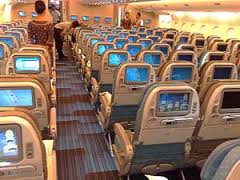
Are We Nearing the End of Seat-Back Entertainment in Airplanes?
I remember my first exposure to in-flight entertainment (IFE) vividly. It came in 1976 on an Air Canada L-1011 flying from Bridgetown to Toronto. An honest-to-god projector was brought down from the ceiling, loaded up with reel after reel of film and projected a dim, shady image on a big screen at the front of the cabin. We listened through acoustic earbuds that worked like stethoscopes. It was very, very low-tech.
Air Canada used to be recognized for some pretty decent IFE. But I may be biased. Back then, I had a job supplying music several hours of music programming to Air Canada every month. That gig ended in the early 2000s after 9/11 and when the airline moved to a deal with XM Radio and away from hosted programs. I was bummed out, of course–but outside of the new hardware on their 787s, Air Canada really hasn’t ungraded their offerings much. The airline’s IFE is very much middle-of-the-pack when it comes to the rest of the industry. (In my experience, Singapore Airlines’ KrysWorld is my favourite, although I’ve heard amazing things about both Emirates and Etihad.)
Air Canada does offer something slightly different with their Rouge brand. In effort to save weight, the 30-plus Rouge aircraft in the fleet don’t have seat-back IFE systems. Instead, you use your tablet or phone to log into a closed WiFi system which then offers you a (very limited) choice of viewing and listening. Other airlines offer something similar.
This where it’s started to get interesting. In-flight WiFi could actually be the death of traditional IFE. The BBC explains why.
In 1936, just over a decade after passenger air travel started with the invention of the airship, the dirigible Zeppelin Hindenburg sported a full-blown piano, along with a lounge, dining room, smoking room, and bar. Before that, it was common for airships to have musicians playing on smaller instruments such as accordions to help passengers while away the hours (and days). Long flights, it seems, have always needed entertainment to stop people getting bored.
After World War II and until the 1990s, the most plane passengers could expect was a movie at the front of a cabin: first using a projector, and later shown on a few sparse TV screens lowered from the ceiling. Some airlines also offered music to passengers, first through little airtubes blowing sound into your ears, and then later via some proper electric headphones plugged into a socket in the seat’s armrest.
Now of course, keeping passengers entertained is a serious business. And this doesn’t come cheap – airlines spend as much as $15,000 on seats featuring on-demand TV, movies or games as we tick off the miles. But in-flight entertainment is about to go through another transformation, now that planes are connected up to the internet and passengers can stream content right to their personal gadgets. How will this change your flight experience?




I first flew in 2006 and I swear I listened to a curated show of yours on the flight. You mean to tell me it was 6 years old at that point?
Or, you know, travelers could use local storage on their devices and play media from there. At least that’s mostly legal for music and books. For video… there’s TED talks or indie Creative Commons works like Sita Sings the Blues, and then the options get limited very quickly.